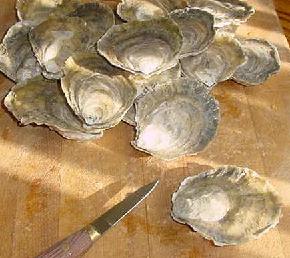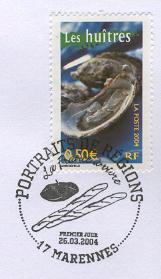France
John McCabe
 Many countries
produce lots of wonderful oysters. However, no country in the
world can offer a more complete oyster experience than France.
Is it because French oysters always taste better than, for instance,
American, British, Irish or Canadian oysters? No. The difference
is that you're getting a French oyster in France, which means
that it is served up along with a boat load of savoir vivre,
backed by lots of cultivation savoir faire and national
pride, all in a setting of immense cultural wealth. Regardless
of how good or bad the service might be, no doubt ever exists
in the mind of the French person serving you that you should
feel privileged to be served the finest oysters in the world.
Many countries
produce lots of wonderful oysters. However, no country in the
world can offer a more complete oyster experience than France.
Is it because French oysters always taste better than, for instance,
American, British, Irish or Canadian oysters? No. The difference
is that you're getting a French oyster in France, which means
that it is served up along with a boat load of savoir vivre,
backed by lots of cultivation savoir faire and national
pride, all in a setting of immense cultural wealth. Regardless
of how good or bad the service might be, no doubt ever exists
in the mind of the French person serving you that you should
feel privileged to be served the finest oysters in the world.
France and oysters go way back. Since Roman
times, the coast of France has been the place of choice where
prime oysters can be found. In modern times, France was the first
country in all of Europe to start cultivating oysters on a large
scale. It's called "L'ostréiculture"
and, in turn, the growers are referred to as "Ostréiculteurs"
or "Parqueurs". The oyster business is taken
very seriously by growers, marine biologists (IFREMER), and ultimately
by French connoisseurs. France controls more than 2,000 miles
of coastline, featuring some of the finest oyster beds in the
world. In 2005, approximately 3,400 French oyster growers produced
an estimated 518 million Euros in sales.
From North to South there are seven distinct
growing regions: Normandy, North-Brittany, South-Brittany, West-Central,
Marennes-Oléron, Arcachon, and the Mediterranean. Although
some of these areas are far more famous than others, they all
produce excellent oysters.
Two culinary oyster species are cultivated
in France:
 * The Pacific oyster (Crassostrea gigas) was introduced
in the 1970s both from Japan (seed oysters) and British Columbia
(brood oysters). This oyster species is referred to in the French
market as "Huître creuse" or collectively
simply as "Creuses". Some folks might still
refer to this species as a "Japonaise". It replaced
a similar (some claim same) oyster species in the early 1970s
called the "Portuguese oyster" (Crassostrea angulata),
nostalgically remembered as the "Portugaise".
It was then also known as a "Creuse" among oyster
lovers. Now, nearly extinct due to having been ravaged by gill
diseases, the Portuguese oyster is commercially insignificant.
Its demise (in the late 1960s - early 1970s) brought the French
oyster industry to the brink of collapse. The cultivation transition
from the Portuguese oyster to the Pacific oyster was rapid and
most successful, as the traditional cultivation methods of the
growers could be continued unaltered. Consumers also readily
accepted the new "Japonaise", as both species look
very similar. More than 90% of all the oysters produced in France
today are Pacific oysters.
* The Pacific oyster (Crassostrea gigas) was introduced
in the 1970s both from Japan (seed oysters) and British Columbia
(brood oysters). This oyster species is referred to in the French
market as "Huître creuse" or collectively
simply as "Creuses". Some folks might still
refer to this species as a "Japonaise". It replaced
a similar (some claim same) oyster species in the early 1970s
called the "Portuguese oyster" (Crassostrea angulata),
nostalgically remembered as the "Portugaise".
It was then also known as a "Creuse" among oyster
lovers. Now, nearly extinct due to having been ravaged by gill
diseases, the Portuguese oyster is commercially insignificant.
Its demise (in the late 1960s - early 1970s) brought the French
oyster industry to the brink of collapse. The cultivation transition
from the Portuguese oyster to the Pacific oyster was rapid and
most successful, as the traditional cultivation methods of the
growers could be continued unaltered. Consumers also readily
accepted the new "Japonaise", as both species look
very similar. More than 90% of all the oysters produced in France
today are Pacific oysters.
 * The European oyster (Ostrea edulis) is the native
oyster of France. It is called "Huître plate"
or simply "Plate". In some areas it is also
called a "Gravette". A so called "Pied de cheval"
("horse hoof") designates a particularly large (and
rare) European oyster. The European oyster is often considered
the classic oyster of France. Once upon a time, it was the mainstay
of the French oyster industry. Historical over-harvesting and,
later, devastating oyster diseases (Martellia refringens, Bonamia
ostrea) have reduced its numbers greatly. In terms of total oyster
production, the European oyster accounts for single digit percentages.
Hence, it is also the most expensive
* The European oyster (Ostrea edulis) is the native
oyster of France. It is called "Huître plate"
or simply "Plate". In some areas it is also
called a "Gravette". A so called "Pied de cheval"
("horse hoof") designates a particularly large (and
rare) European oyster. The European oyster is often considered
the classic oyster of France. Once upon a time, it was the mainstay
of the French oyster industry. Historical over-harvesting and,
later, devastating oyster diseases (Martellia refringens, Bonamia
ostrea) have reduced its numbers greatly. In terms of total oyster
production, the European oyster accounts for single digit percentages.
Hence, it is also the most expensive  oyster
in France (or in all of Europe for that matter).
oyster
in France (or in all of Europe for that matter).
Inset image: A beautiful French stamp
celebrating oysters. Both oysters pictured are Pacific oysters.
The European oyster, once France's claim to fame, failed to make
an appearance, likely because it has become rather scarce and
accounts for only a small percentage of the oyster harvest. Click
to view full cover with stamp (large image).
In the 19th century, there were
three oyster capitals in the world: Paris, London and New York.
Although fabulous oysters are still served in London and New
York, these two grand cities have since lost their prestigious
titles as oyster capitals of the world. Paris has not. To this
day, this city offers countless opportunities to enjoy oysters,
be it in restaurants or from a side walk vendors. Some kind of
dry white wine or Champagne is generally suggested as an accompaniment.
The classics in Paris are oysters from legendary French oyster
cultivation areas such as Cancale,
Marennes-Oléron,
and Arcachon.
The coast of France also offers fantastic oyster experiences.
Virtually anywhere along the French coastline (including the
Mediterranean)
delicious oysters are served. Quite "naturellement",
the locals in these areas praise their local oysters as the non
plus ultra in taste. Usually a particular local wine is recommended
by the host in order to properly optimize both the taste of the
oyster as well as the "terroir experience" overall.
Much like French wine growing areas, oyster cultivation areas
are often informally refered to as "crus". The
best part about the French coast is, however, the price of oysters.
They usually cost half of what is  charged in Paris.
charged in Paris.
Inset image: "Still Life with Oysters"
(1940) by the famous French artist Henri Matisse (1869 - 1954)
on a stamp from the Maldives. The oysters that "modeled"
for his painting were Portuguese oysters (Crassostrea angulata),
a species almost extinct today in French waters. It has has since
been replaced by the Pacific oyster (Crassostrea gigas). This
oil on canvas painting is in the care of the Kunstmuseum in Basel,
Switzerland.
France produces about 130,000 to 145,000
metric tons of Pacific oysters (Crassostrea gigas) annually.
Additionally the French produce about 1,000 to 3,000 metric tons
of European oysters (Ostrea edulis).
As oysters go, the French have long been
the undisputed leader in all of Europe. Not only do the French
produce the lion share of the oysters in Europe, they are also
their own best customers. More than 90% of the oysters produced
in France are consumed by the French. The French oyster business
traditionally starts booming between Christmas and New Year's
Day. About 50% of the annual oyster production is consumed during
this time.


